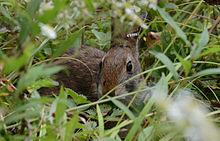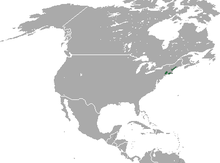| New England cottontail[1] | |
|---|---|

| |
| Scientific classification | |
| Domain: | Eukaryota |
| Kingdom: | Animalia |
| Phylum: | Chordata |
| Class: | Mammalia |
| Order: | Lagomorpha |
| Family: | Leporidae |
| Genus: | Sylvilagus |
| Species: | S. transitionalis
|
| Binomial name | |
| Sylvilagus transitionalis (Bangs, 1895)
| |

| |
| New England cottontail range | |
The New England cottontail (Sylvilagus transitionalis), also called the gray rabbit, brush rabbit, wood hare, wood rabbit, or cooney, is a species of cottontail rabbit represented by fragmented populations in areas of New England and the state of New York, specifically from southern Maine to southern New York.[2][4][5] This species bears a close resemblance to the eastern cottontail (Sylvilagus floridanus), which has been introduced in much of the New England cottontail home range. The eastern cottontail is now more common in it.[6]
Litvaitis et al. (2006) estimated that the current area of occupancy in its historic range is 12,180 km2 (4,700 sq mi) - some 86% less than the occupied range in 1960.[2] Because of this decrease in this species' numbers and habitat, the New England cottontail is a candidate for protection under the Endangered Species Act. Cottontail hunting has been restricted in some areas where the eastern and New England cottontail species coexist in order to protect the remaining New England cottontail population.[7]
Rabbits require habitat patches of at least 12 acres to maintain a stable population. In New Hampshire, the number of suitable patches dropped from 20 to 8 in the early 2000s. The ideal habitat is 25 acres of continuous early successional habitat within a larger landscape that provides shrub wetlands and dense thickets. Federal funding has been used for habitat restoration work on state lands, including the planting of shrubs and other growth critical to the rabbit's habitat. Funding has also been made available to private landowners who are willing to create thicket-type brush habitat which doesn't have much economic value.[6]
- ^ Hoffman, R.S.; Smith, A.T. (2005). "Order Lagomorpha". In Wilson, D.E.; Reeder, D.M (eds.). Mammal Species of the World: A Taxonomic and Geographic Reference (3rd ed.). Johns Hopkins University Press. p. 211. ISBN 978-0-8018-8221-0. OCLC 62265494.
- ^ a b c Litvaitis, J.; Lanier, H.C. (2019). "Sylvilagus transitionalis". IUCN Red List of Threatened Species. 2019: e.T21212A45181534. doi:10.2305/IUCN.UK.2019-2.RLTS.T21212A45181534.en. Retrieved 12 November 2021.
- ^ "NatureServe Explorer 2.0". explorer.natureserve.org. Retrieved 20 October 2022.
- ^ "New England Cottontail rabbit (Sylvilagus transitionalis)". U.S. Fish and Wildlife Service.
- ^ Marianne K. Litvaitis; John A. Litvaitis (1996). "Using Mitochondrial DNA to Inventory the Distribution of Remnant Populations of New England Cottontails". Wildlife Society Bulletin. 24 (4): 725–730. JSTOR 3783166.
- ^ a b Keefe, Jennifer (April 24, 2011). "Cottontail gets help with habitat restoration". Foster's Daily Democrat. Retrieved 25 April 2011.
- ^ "Hunting: Small game, furbearers, other species". New Hampshire Fish and Game Department. Archived from the original on 2007-10-14.

